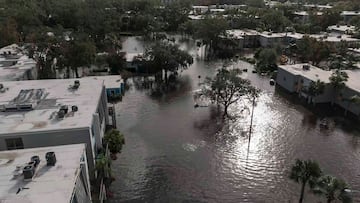Hurricane Season 2024 Retrospective: How the reality compared to the forecast
A look at the 2024 Hurricane Season and how it compares to forecast released by NOAA in the spring.


The 2024 Atlantic Hurricane Season came to an official end on November 30. Before each season, the National Oceanic and Atmospheric Administration (NOAA) releases a forecast, and this year, they projected “above-normal hurricane activity in the Atlantic basin this year” with “a range of 17 to 25 total named storms.” Of those named storms, NOAA forecasted that eight would become hurricanes, which means they are storms with winds above 74 mph, and that anywhere between four and seven of the hurricanes that developed would be classified as “major,” meaning they at one point reached Category 3, 4, or 5.
Not all storms escalate to hurricane status, but many reach significant levels of severity that warrant attention. Naming these storms serves an important purpose, as it allows officials to communicate effectively with residents and prepare them for potential natural disasters. Even when hurricanes, such as Kirk and Leslie, do not make landfall, they are assigned names due to their capacity to pose risks for maritime travel and influence tidal patterns along coastal regions.
How reality stands up to the forecast
Throughout the 2024 season, there were eighteen named storms, eleven of which developed into hurricanes, exceeding NOAA’s forecast.
- Alberto - Tropical Storm
- Beryl - Hurricane - Category 5
- Chris - Tropical Storm
- Debby - Hurricane - Category 1
- Ernesto - Hurricane - Category 2
- Francine - Hurricane - Category 2
- Gordon - Tropical Storm
- Helene - Hurricane - Category 4
- Isaac - Hurricane - Category 2
- Joyce - Tropical Storm
- Kirk - Hurricane - Category 4
- Leslie - Hurricane Category 2
- Milton - Hurricane - Category 5
- Nadine - Tropical Storm
- Oscar - Hurricane Category 1
- Patty - Tropical Storm
- Rafael - Hurricane Category 3
- Sara - Tropical Storm
Five were “major storms,” which fall within the range projected by the public agency. The season got off to a strong start with Hurricane Beryl, which broke records as the earliest category 5 storm to develop in the Atlantic. Hurricane Beryl battered the Lesser Antilles and Windward Islands, which are not often the targets of hurricanes, particularly too early in the season.
Why stronger storms develop in the Gulf of Mexico
There was a temporary lull during the summer for residents in the United States that ended with Hurricane Helene, which battered the Southeast and, in particular, North Carolina. Some communities were devastated by the storm, and aid from the federal government continued as residents returned and attempted to rebuild their lives. Two weeks later, Hurricane Milton hit Florida. Though the storm made landfall a little farther south than Hurricane Helene, many residents of the Sunshine State were displaced again.
Related stories
These stronger storms are partially caused by warmer waters in the Gulf of Mexico, which remain hotter for longer due to climate change. As storms develop, they become much more powerful when traveling over these warmer waters.
Get your game on! Whether you’re into NFL touchdowns, NBA buzzer-beaters, world-class soccer goals, or MLB home runs, our app has it all. Dive into live coverage, expert insights, breaking news, exclusive videos, and more – plus, stay updated on the latest in current affairs and entertainment. Download now for all-access coverage, right at your fingertips – anytime, anywhere.
Complete your personal details to comment